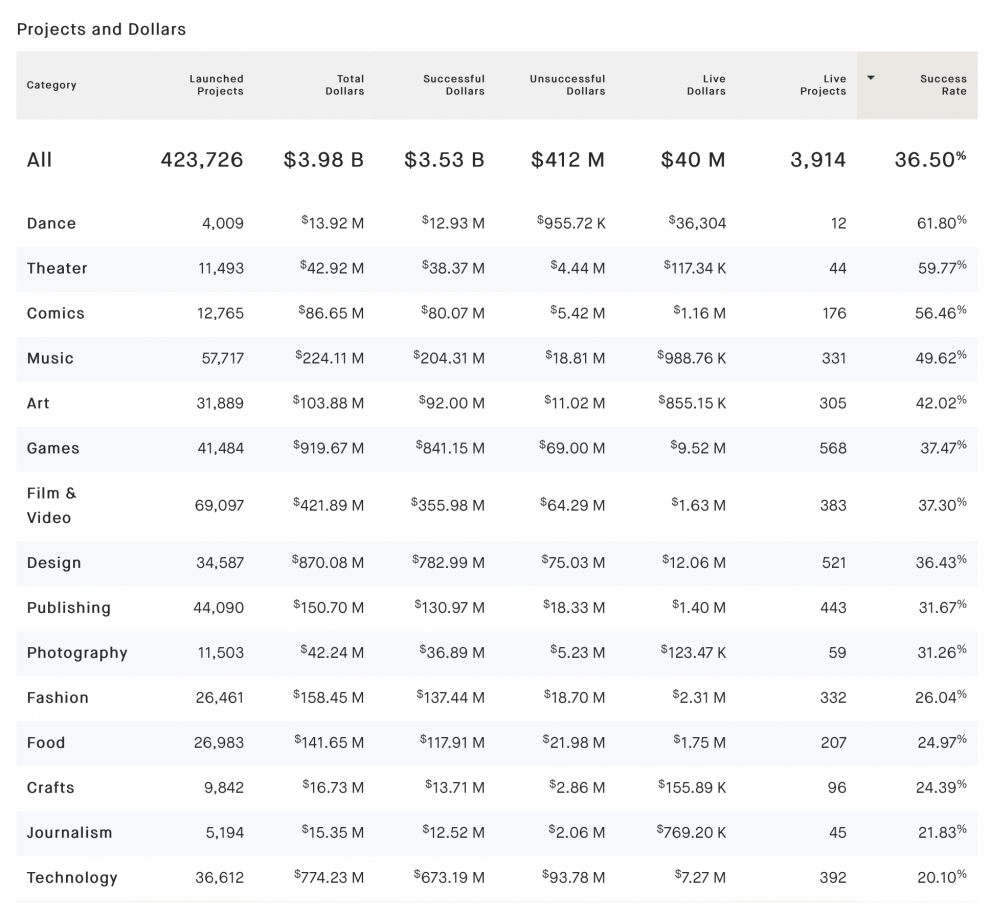
The first time the National Observer tried to raise money on Kickstarter, they couldn’t get the framing quite right.
The Canadian investigative news outlet reached out to Kickstarter’s team for guidance. A few tweaks here and there and things were off and running: The National Observer has since raised $204,842 Canadian ($155,884 USD) for reporting projects across three different Kickstarters. For an organization just getting started at someone’s dining room table, getting that little bit of assistance from Kickstarter staff meant the National Observer could actually exist.
Now, Kickstarter is making that assistance a little less ad hoc, in the form of a journalism outreach lead position. (They’re still in the hiring process but have candidates.) Meanwhile, it’s also handing off Drip — their Patreon-lookalike for sustained support that the National Observer had beta-tested — to new leadership.
News organizations have spent 2018 seeking new forms of reader revenue — whether that’s an updated subscription funnel emphasizing newsletters, an empathy-heavy membership appeal, or even a Kickstarter campaign. Readers have become more comfortable with the thought of paying for digital news (if not quite like the days of subsidized news), with young Americans in particular starting to fork over cash for online news in greater numbers. What hasn’t changed about Kickstarter is that launching a campaign on the platform comes with the opportunity to excite supporters quickly — and potentially bring in a spike of initial funding for an ambitious journalism organization or reporting project.Around the same time as The National Observer’s first Kickstarter to support its reporting, in 2014, Margot Atwell joined the crowd-fundraising platform as the publishing outreach lead, a job which at the time included journalism. She’s now the director of publishing, which includes overseeing the journalism outreach position.
“As a public benefit corporation, Kickstarter is really concerned with making the world a better place,” Atwell told me, acknowledging “that can seem a little hokey [but] I think that good journalism is really important for making a fair, just, inclusive society. At this particular moment in time, having good journalists compensated and able to do excellent work is one of the most important issues facing all of us.”
Seven of the 10 most-funded journalism projects in Kickstarter’s history have taken place in the last year, though only 13 of Kickstarter’s journalism projects have ever raised more than $100,000. (Out of the 1,124 successfully funded journalism projects, 53 percent amassed between $1,000 and $9,999.) That top shelf will soon include Tortoise, a slow-journalism endeavor from the BBC’s former head of news James Harding, Dow Jones ex-president Katie Vanneck-Smith, and former U.S. ambassador Matthew Barzun. It’s raised over $585,000 from over 1,800 backers so far, making it Kickstarter’s most-funded journalism project ever. (It won’t make Kickstarter’s official most-funded lists until it closes November 16.)
By 2012, three years after its own launch, Kickstarter had gathered $2.23 million in pledges for 662 journalism projects. The average success rate for journalism projects hovered around 37 percent, lower than the 44 percent for projects overall.Crowdfunding with swag rewards has been one of many attempts of the journalism industry to find some new cash, and Kickstarter is not the only option out there. The San Diego Union-Tribune used GoFundMe to experiment with crowdfunding in support of those spotlighted by the newspaper’s reporting, though GoFundMe is more home to medical and personal fundraisers rather than projects with reward levels. (If you search “journalism” on that platform, you’ll find supporters sent $47,622 to the journalism program at Stoneman Douglas High School and $205,402 to Capital Gazette journalists after each organization experienced a mass shooting.) Patreon has served as another conduit for money to journalists, though in a more controlled manner of a few bucks per month per person; Canadaland, national political news (okay, Trump news) roundup What The Fuck Just Happened Today, and local organization The Asheville Blade all use it.
By 2018, according to Kickstarter’s public stats page, journalism projects have sunk to an average success rate of 21.8 percent — well below the platform’s overall average of 36.5 percent. (Remember, projects have to reach their publicly-set threshold to get any of the money on Kickstarter.) Successful projects have earned $12.52 million and only $2.06 million was returned to contributors after projects didn’t hit viability. Kickstarter has hosted more than 5,000 journalism projects, edging out “dance” as the second-least used category. (Though to be fair, journalism was under publishing as a subcategory until 2014.)

“I was like ‘I don’t know, if we do Kickstarter and don’t get our $25,000 [goal amount], we’ll have to give it all back — let’s be more careful,'” Shamus Toomey, Block Club’s editor-in-chief, told me. The Kickstarter turned into the organization’s “de facto website for the first couple of days,” he added, since the team’s pitch (including a video) was comprehensive and they were able to update supporters as the fundraising progressed, like when it hit another milestone and they were able to hire another reporter.
WOW! $100,000 Y'ALL. This means we can hire ANOTHER REPORTER to cover Chicago's neighborhoods. This is just the beginning… we can't wait to make you proud.https://t.co/4x9MYeTHBS
— Block Club Chicago (@BlockClub_CHI) February 7, 2018
Block Club didn’t work much with Kickstarter’s staff on finessing the campaign before launch, Toomey said, but the project caught Atwell’s eye as the donations flooded in. “Once we went live and started getting the donations within minutes, Kickstarter turned us into a ‘Project We Love,’ which ratchets up the visibility of the project on their site,” he said. (The National Observer also received a front-page placement during some of its campaigns, Linda Solomon Wood, the site’s founder and editor-in-chief, said.) “Most of the donations were coming from Chicago, but we could really feel that we were getting the wind behind us, and I know Kickstarter played a role in that.” (Another Civil-backed newsroom, The Colorado Sun, also used Kickstarter to gain ground at launch, raising over $160,000.)
Toomey is still on the Civil train. “I would love to be a part of Civil forever,” he said. “I’d like to think we could’ve conquered some of the hurdles that Civil has helped us get over, but I don’t know if that’s true. They helped us get a subscription vendor, they set up the site, they’ve given us legal help and business help.” But he also pointed out that growing subscriptions is the key move that DNAInfo never tried and that Block Club is trying to build into its own DNA: “We need to make this work as a functioning subscription site, and that’s our No. 1 goal at this point.”
“We were doing an invitation-only beta to feel out that idea, and in the end we had 100 creators on board and it was a fledgling community. But we decided we would be better off focusing on the core of what we do, which is Kickstarter,” David Gallagher, Kickstarter’s senior director of comms (and a former New York Times editor), said. “Running these two platforms simultaneously and essentially building one as we went was distracting from the core of what we’re here for.”
The National Observer agreed to test Drip for Kickstarter — but left after only a few months. Wood said the expense of time and energy wasn’t worth the rewards, and the Observer already had subscriptions and audiences set up on other platforms. “For us, the slow trickle of support didn’t really work for making anything possible in terms of the scale of what it really takes to do what we were trying to do, which was to document hate crimes, hate speech, and the rise of the far right in Quebec,” Wood said. “You and I both know it’s going to take more than a drip of money to help journalism.”
That’s part of the question the journalism outreach lead is being hired to address, in addition to identifying and recruiting interesting potential projects to join Kickstarter and helping shape projects once they’re onboard. Journalism projects on Kickstarter can be part of a launch campaign, like Block Club’s and Tortoise’s, or used to fund specific reporting initiatives like the National Observer’s reporting on conflicts associated with Canada’s tar sands, former Nieman Fellow Paul Salopek’s slow-journalism walk around the world with National Geographic, and Planet Money’s interactive investigation that traced the global supply chain of a t-shirt and then mailed those t-shirts to backers. (“I know more about this t-shirt than anything else I own,” Gallagher said proudly.)
Still, a journalism Kickstarter has an average 1-in-5 chance of hitting its funding minimum. Many of the Kickstarters that have broken records this year came out of the demise of other publications and frustration with the traditional media structure — see DNAInfo, The Denver Post, even the BBC and The Wall Street Journal — and they hit on a critical mass of folks similarly frustrated with the status quo. To have a Kickstarter that works, Atwell said, you need more than just cool swag: “By virtue of how the platform works, in order to have a successful project, you have to build a community.”